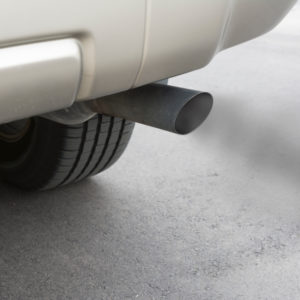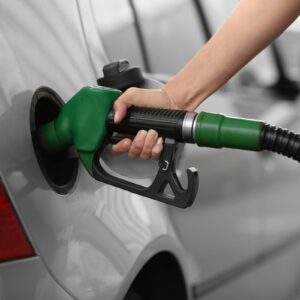In the debate over diesel vs. gasoline emissions, diesel usually comes off as the less clean fuel. However, does that hold true today? We’ve made various technological advancements since the first diesel cars appeared in the early Thirties. Furthermore, some scientific studies show that newer diesel engine models produce lower levels of certain pollutants than their gas counterparts.
Let’s examine gasoline vs. diesel emissions more closely. We can find out if diesel cars have reached the same or superior level of efficiency and emission control as gas cars.
Carbonaceous Particulate Matter in Diesel vs. Gasoline Emissions
Many researchers have investigated tailpipe emissions from diesel and gasoline cars. In 2017, Alessandro A. Zardini published the results of his team’s examination of carbonaceous particulate matter (PM) in vehicle emissions.
Carbonaceous PM originates from the reaction of organic compounds and gases in the air. Composed of black carbon and organic aerosols, they have toxic effects when inhaled. Carbonaceous PM in passenger car emissions are often secondary organic aerosols (SOA).
Diesel cars emit more nitrogen oxides (NOx) and fine particulate matter like carbonaceous PM and SOAs. Earlier diesel engine designs produce emission levels that exceed current standards, but newer engines feature particulate filters that reduce emissions by capturing polluting particles in exhaust gases.
The researchers sampled emissions emitted by gasoline and diesel cars with particulate filters at both 19 °F (-7 °C) and 72 °F ( 22 °C) in their laboratory. They collected both raw exhaust and diluted emissions.
According to the study, gasoline cars produce more carbonaceous PM and SOAs than diesel cars with particulate filters. Emission levels were worse at 19 °F because the catalytic converter was running cold, which reduced its efficiency at breaking down pollutants.
Also, diesel cars emitted 10 times more NOx than gasoline cars at both temperatures. So, while diesel engines produced higher levels of one pollutant, they created reduced amounts of another type of toxic substance.
The study notes that it didn’t cover every possible factor. For example, diesel cars might release more emissions than gasoline cars while driving at high speeds or for longer periods over greater distances. Also, the laboratory environment differs from driving conditions in the real world.
Together with other studies, the research does indicate that diesel cars might not deserve their reputation for generating more pollution than gasoline cars.

Other Pollutants in Gasoline vs. Diesel Emissions
Carbonaceous PM are only some of the pollutants present in vehicle pollution. When you compare diesel vs. gasoline emissions, you must look at other substances like NOx and sulfur oxides.
Here are some of the most common pollutants that you must look out for when weighing the severity of gasoline vs. diesel emissions:
Carbon Dioxide Emissions
It’s common knowledge that diesel cars emit more carbon dioxide (CO2) emissions than gasoline cars. While this isn’t wrong, there’s a nuance to how CO2 emissions are measured.
On a per-gallon basis, diesel produces more CO2 than gasoline. The US Energy Information Administration stated that combusting a gallon of diesel generates 22.38 pounds of CO2. Compare this with a gallon of non-ethanol gasoline, which produces roughly 19.64 pounds of the same pollutant.
What many people forget to take into account is fuel efficiency. They assume that diesel and gasoline engines generate the same energy output when they burn identical amounts of fuel.
However, diesel engines need less fuel to produce the same amount of energy. They eke between 25 and 35 more miles out of a gallon of fuel than their gasoline-powered counterparts.
What does that mean? Diesel cars produce more CO2 per-gallon than gasoline cars. But in terms of gas mileage, diesel engines release 12.5 to 20% less CO2 per mile, making diesel the cleaner option over longer distances.
Carbon Monoxide Emissions
Carbon monoxide (CO) is one of the most toxic pollutants in vehicle emissions. Even small amounts can prove extremely hazardous to human health if inhaled.
Depending on factors, gas engines can release emissions with 1 to 1.9% of CO content. Meanwhile, diesel engines generate zero CO.
Sulfur Dioxide Emissions
Sulfur dioxide (SO2) is a pollutant formed when sulfur in fuel mixes with oxygen during combustion. It’s usually one of the major pollutants in diesel emissions.
Before 1993, diesel used to have an average of 3,000 parts per million (ppm) sulfur. In contrast, gasoline contained smaller amounts of the element. Thus, diesel emissions usually had more SO2 than gasoline emissions.
Things changed when the US Environmental Protection Agency (EPA) began regulating the amount of sulfur in diesel fuel. In 1993, the government agency required petroleum refiners and marketers to introduce low-sulfur diesel with a maximum of 500 ppm sulfur content. In 2006, the EPA phased in stricter regulations that called for a maximum of 15 ppm sulfur in ultra-low-sulfur diesel.
Today, ultra-low-sulfur diesel and gasoline have roughly identical sulfur content. By extension, the two fuels produce the same SO2 emissions. And if you factor in fuel efficiency, diesel engines emit less SO2 per mile when compared to gasoline engines.
Ultrafine Particulate Matter
Particulate matter comes in various sizes. You can see some with the unaided eye, while others are so fine that you require specialized equipment like powerful microscopes to observe them.
Gasoline itself doesn’t produce ultrafine particulate matter (UFPM) during combustion. However, it often includes fuel additives called octane boosters, which create such pollutants when burned.
Octane boosters increase the octane rating of gasoline. The higher the rating, the greater its compressive resistance. A high rating also prevents knocking that can damage the engine.
Unfortunately, octane boosters usually contain aromatic hydrocarbons. When octane boosters burn, they release aromatics into the air as UFPM that can enter the human body through inhalation or passing through the skin. Aromatics are toxic to humans and can cause various health problems.
Diesel fuel doesn’t have this problem because it dispenses with octane boosters. It enjoys a high compressive resistance, especially when compared to pure gasoline. Thus, diesel doesn’t need fuel additives that can raise its octane rating in exchange for increasing ultrafine particulate matter levels.
Is diesel cleaner than gasoline? While there are cleaner options, diesel produces lower levels of specific pollutants in certain conditions. If you drive a relatively recent diesel car with a particulate filter and use fuel with low sulfur content, you can enjoy reduced emission levels comparable to those of gasoline cars.
Types of Gasoline and Diesel
You’ve probably noticed that gasoline has a few variations when refueling at the pump.
Regular, mid-grade, and premium are the common types of gasoline. Octane levels are their main differentiating factor. For gasoline, high octane levels translate to high compression ratios.
Octane ratings for gasoline:
- Regular – 87
- Mid-grade – 89-90
- Premium 91-94
As for diesel fuel, it can either be clear or dyed.
Also referred to as “auto diesel,” clear diesel has a light green hue that gets darker as the diesel fuel degrades. Clear diesel is intended for on-road applications.
Meanwhile, dyed diesel is mixed with a red, blue, or purple solvent. This type of diesel fuel has a higher sulfur content than clear diesel and can only be used in construction, farming, and aviation vehicles.
Key Differences Between Gasoline and Diesel Fuel
Gasoline and diesel fuel differ in terms of power and efficiency.
Power
Gasoline can produce more power than diesel because it’s more refined and volatile. It also burns faster than diesel.
Meanwhile, diesel is a thicker substance, has a higher density, and burns more slowly than gasoline.
Generally, diesel fuel can help engines produce 20% more energy than gasoline-powered ones while consuming the same amount of fuel.
Efficiency
On one hand, diesel engines generally have a low RPM performance and high compression ratio, resulting in better thermal and fuel efficiency than gasoline engines.
On the other hand, gasoline engines can’t operate at an extremely high compression ratio because gasoline combusts at a lower temperature than diesel.
Should a gasoline engine operate at the same rate as a diesel, uncontrolled combustions might occur, eventually damaging the engine.
When comparing the two types of fuel, you might not notice the efficiency of diesel fuel during stop-and-go traffic. The advantages of diesel fuel over gasoline is most noticeable at highway speeds.
Any information provided on this Website is for informational purposes only and is not intended to replace consultation with a professional mechanic. The accuracy and timeliness of the information may change from the time of publication.






























